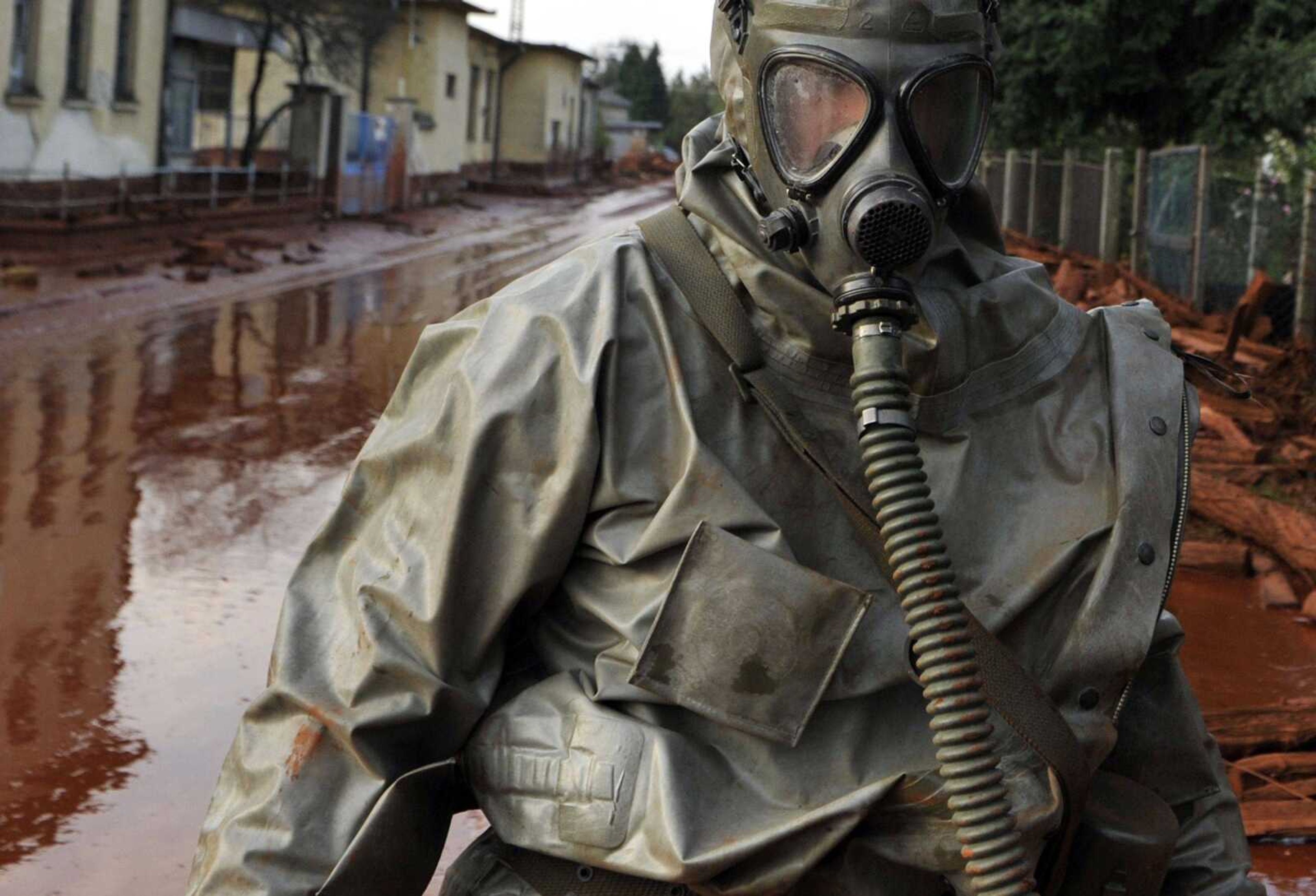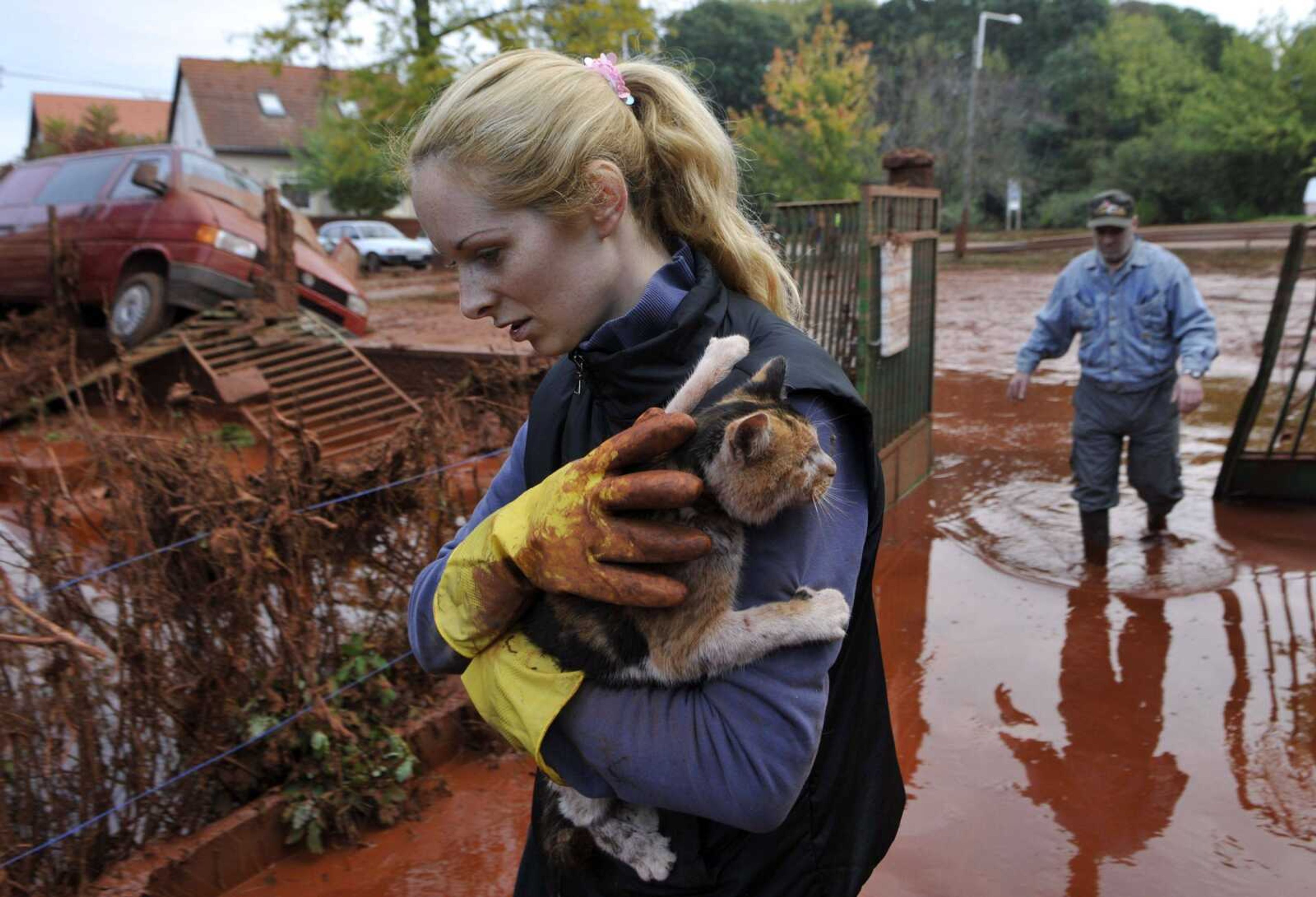Toxic sludge floods village
KOLONTAR, Hungary -- A lethal torrent of toxic red sludge from a metal refinery engulfed towns in Hungary, burning villagers through their clothes and threatening an ecological disaster Tuesday as it swept toward the Danube River. The flood of caustic red mud triggered a state of emergency declaration by Hungarian officials. At least four people were killed, six were missing and 120 injured, many with burns...
KOLONTAR, Hungary -- A lethal torrent of toxic red sludge from a metal refinery engulfed towns in Hungary, burning villagers through their clothes and threatening an ecological disaster Tuesday as it swept toward the Danube River.
The flood of caustic red mud triggered a state of emergency declaration by Hungarian officials. At least four people were killed, six were missing and 120 injured, many with burns.
Hundreds were evacuated in the aftermath of the disaster Monday, when a gigantic sludge reservoir burst its banks at an alumina plant in Ajka, a town 100 miles southwest of Budapest, the capital. The torrent of sludge inundated homes, swept cars off roads and damaged bridges.
Named for its bright red color, the material is a waste product in aluminum production that contains heavy metals and is toxic if ingested.
In Kolontar, the town closest to the plant, Erzsebet Vein-gartner was in her kitchen when the 12-foot-high wave of red slurry hit, sweeping away everything in its path.

"I looked outside and all I saw was the stream swelling like a huge wave," said the 61-year-old widow who gets by on a $350 monthly pension.
"I lost all my chickens, my ducks, my Rottweiler and my potato patch. My late husband's tools and machinery were in the shed and it's all gone. I have a winter's worth of firewood in the basement and it's all useless now."
Emergency workers wearing masks and chemical protection gear rushed to pour 1,000 tons of plaster into the Marcal River in an attempt to bind the sludge and keep it from flowing on to the Danube some 45 miles away. Nearby, villagers waded through the toxic mud trying to salvage possessions with little more than rubber gloves as protection.
The 1,775-mile-long Danube passes through some of the continent's most pristine vistas from its origins as a Black Forest spring in Germany to its end point as a majestic stretch of water emptying into the Black Sea.
Now a murky green -- not blue as immortalized in the Strauss waltz -- the river flows through four former communist nations. One of the continent's greatest treasuries of wildlife, it has been the focus of a multibillion dollar post-communist cleanup. Cormorants, swans and other birds are now common sights on the river.
Still, high-risk industries such as Hungary's Ajkai Timfoldgyar alumina plant are still producing waste near some of its tributaries, posing a threat to the waterway.
By Tuesday, about 35.3 million cubic feet of sludge had poured from the reservoir, flooding a 16 square mile area, Environmental Affairs State Secretary Zoltan Illes told the state news wire MTI. He called the spill an "ecological catastrophe."
Dozens of villagers were burned when the caustic material seeped through their clothing. Two women, a young man and a 3-year-old child were killed, and health officials said two of the injured were in critical condition.
Because chemical burns can take days to emerge, seemingly superficial injuries can turn deadly as they penetrate deeper tissue, Dr. Peter Jakabos of Gyor Hospital told state TV.
In nearby Devecser, the sea of muck in Tunde Erdelyi's house was 5 feet high Tuesday and rescue workers had to use an ax to cut through her living room door to let it flow out. Her car had been swept into the garden and her husband's van straddled a fence.
"When I heard the rumble of the flood, all the time I had was to jump out the window and run to higher ground," she said tearfully, adding that she was grateful the family's pet rabbit and cat were safe.
Her husband, Robert Kis, said his uncle was flown by helicopter to Budapest after the sludge "burned him to the bone."
Firefighters and soldiers wearing masks, rubber boots and other protective gear waded through the stricken area Tuesday, flushing away the sludge with hoses, aided by dozens of bulldozers, their loaders scraping the polluted ground.
Hungarian Prime Minister Viktor Orban acknowledged that authorities were caught off guard by the disaster, telling reporters the alumina plant and reservoir had been inspected two weeks earlier and no irregularities had been found.
Red sludge is a byproduct of the refining of bauxite into alumina, the basic material for manufacturing aluminum. Representatives from industry organizations in the U.S. and London could not explain why the Hungarian victims were burned by the material, saying if it is properly treated it is not hazardous.
It is common to store treated sludge in ponds where the water eventually evaporates, leaving behind a dried red clay-like soil, the officials said.
However, Hungarian environmentalist Gergely Simon said the sludge involved in the disaster had been accumulating in the reservoir for decades and was extremely alkaline, with a pH value of about 13 -- nearly equivalent to lye -- and that is what caused the burns.
MAL Rt., the Hungarian Aluminum Production and Trade Company that owns the Ajka plant, said that according to European Union standards, red sludge is not considered hazardous waste.
The company also denied that it should have taken more precautions to shore up the reservoir, a huge structure more than 1,000 feet long and 500 yards wide, and high enough to dwarf trees that survived the torrent.
Clearly angered by the company's suggestions that the substance was not hazardous, Interior Minister Sandor Pinter, snapped: "They should take a swim in it and then they'll see."
This week's spill threatened to eclipse the environmental damage caused 10 years ago, when huge amounts of cyanide poured from a gold mine reservoir in a Romanian town near the Hungarian border into the Danube and four smaller rivers, destroying plant and animal life. Romania, what was then Yugoslavia and Ukraine also were affected.
------
Gorondi reported from Budapest. Associated Press Writer George Jahn in Vienna and Business Writer Jon Fahey contributed to this report.
Connect with the Southeast Missourian Newsroom:
For corrections to this story or other insights for the editor, click here. To submit a letter to the editor, click here. To learn about the Southeast Missourian’s AI Policy, click here.









